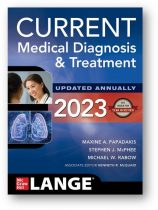 Image Source: McGraw Hill
Image Source: McGraw HillThe 2023 Edition of CURRENT Medical Diagnosis & Treatment has launched on AccessMedicine. As a reminder, you have full access to this text and much more through the library at Seton Hall.
For 60+ years, CURRENT Medical Diagnosis & Treatment has been delivering the authoritative information that students, residents, and clinicians need to build their medical knowledge, expertise, and confidence. Written by top experts in their fields, this unmatched guide enables you to find the answers you need quickly and easily.
This edition provides:
- Coverage of more than 1,000 diseases and disorders
- Comprehensive approach to patient care, focusing on diagnostic tools for day-to-day practice
- Hundreds of drug treatment tables for quick access to indexed trade names and updated drug prices
- Diagnostic and treatment algorithms to present important information at a glance
- Carefully curated, updated references to provide peer-reviewed, evidence-based information, and PMID numbers for quick online access
- Annual update on dynamic viral infections, including SARS-CoV-2/COVID-19 and HIV/AIDS
- Hundreds of full color photographs, illustrations, and algorithms
- Integration directly into Quick Medical Diagnosis & Treatment summaries
Credit to Susan Pluta for the original posting

